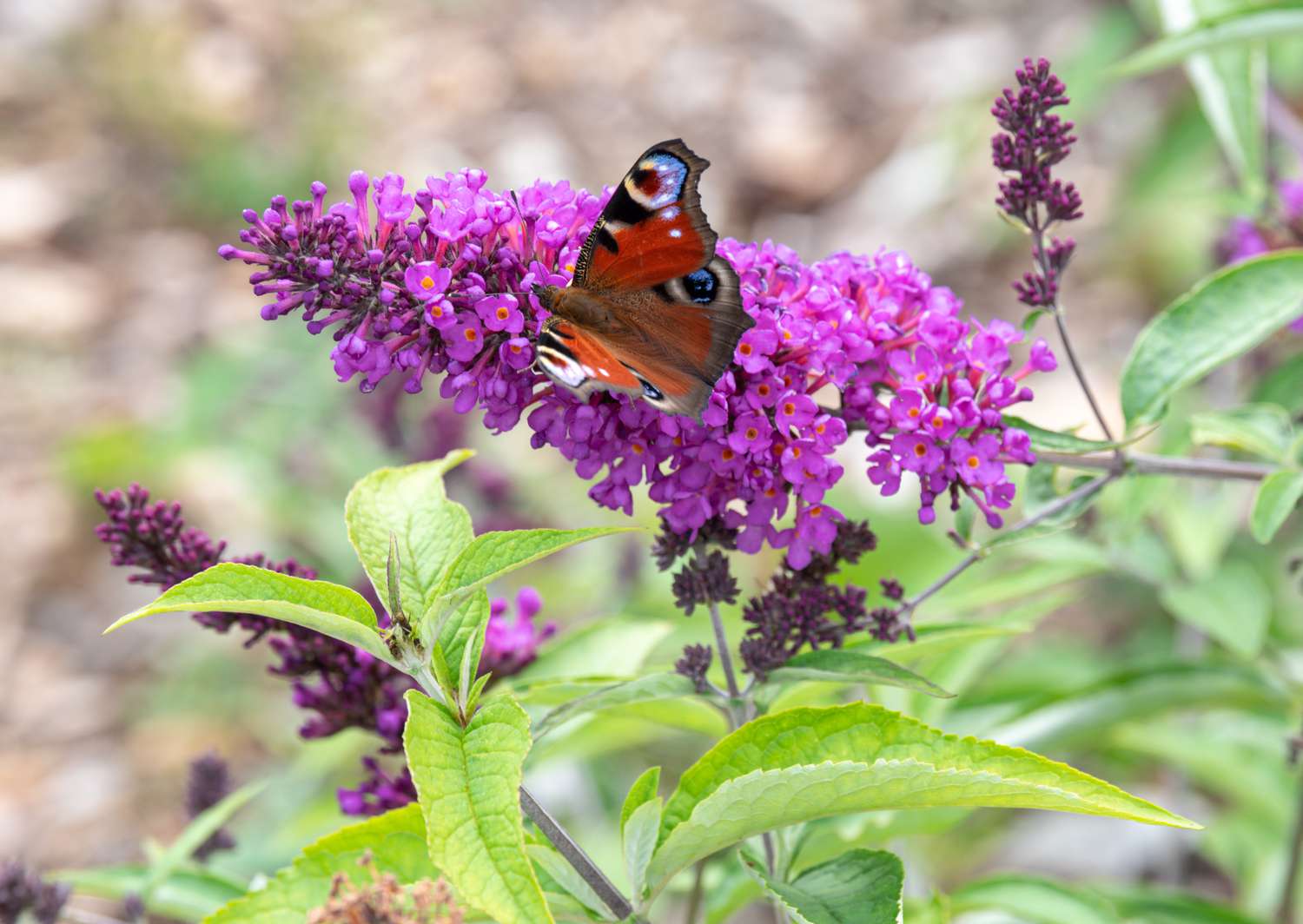
Butterfly bush, also known as Buddleja davidii, is a captivating flowering plant that attracts not only butterflies but also the attention of garden enthusiasts. With its vibrant blooms and sweet fragrance, this shrub adds beauty and charm to any garden or landscape.
In this article, we will explore 18 extraordinary facts about butterfly bush that will deepen your appreciation for this remarkable plant. From its origins and symbolism to its growth habits and ecological benefits, you will gain a comprehensive understanding of why butterfly bush is a favorite among gardeners and nature lovers alike.
So, get ready to embark on a delightful journey through the world of butterfly bush and uncover some fascinating secrets about this incredible plant. Whether you are a seasoned gardener or just starting your green thumb journey, these facts will surely inspire you to incorporate butterfly bush into your own outdoor oasis.
Key Takeaways:
- Butterfly Bush is a colorful, low-maintenance plant that attracts butterflies, bees, and hummingbirds, making it a perfect addition to any garden for nature lovers.
- With its vibrant flowers and medicinal properties, Butterfly Bush symbolizes transformation and renewal, creating a welcoming habitat for butterflies and enhancing biodiversity in gardens.
The Butterfly Bush is a Magnet for Beautiful Butterflies
One of the most fascinating facts about the Butterfly Bush is its ability to attract a wide variety of butterflies. Its colorful flowers release a sweet fragrance that lures butterflies from far and wide, making it a favorite among butterfly enthusiasts and gardeners alike.
It Comes in a Rainbow of Colors
The Butterfly Bush is known for its vibrant and stunning flowers, which come in a range of colors including purple, pink, white, and yellow. This makes it a versatile plant that can add a pop of color to any garden or landscape.
It Can Grow Up to 10 Feet Tall
Another extraordinary fact about the Butterfly Bush is its impressive height. With proper care and conditions, it can reach heights of up to 10 feet, making it a stunning centerpiece for any garden.
The Butterfly Bush is Easy to Grow
Whether you are a seasoned gardener or a beginner, you will be pleased to know that the Butterfly Bush is relatively easy to grow. It thrives in well-drained soil and requires minimal maintenance, making it an ideal choice for busy gardeners.
It Blooms from Summer to Fall
One of the unique characteristics of the Butterfly Bush is its long blooming period. From summer to fall, you can enjoy its beautiful blossoms, attracting not only butterflies but also other beneficial insects like bees.
It is Drought-Tolerant
The Butterfly Bush has impressive drought-tolerant qualities, meaning it can survive in arid climates with minimal watering. This makes it a great choice for gardeners who live in regions with limited water resources.
Butterfly Bush Can be Propagated through Cuttings
If you want to expand your Butterfly Bush collection, you’ll be happy to know that it can be easily propagated through cuttings. Simply take a stem cutting, place it in well-draining soil, and keep it moist until roots form.
It is Native to Asia
The Butterfly Bush, also known by its scientific name, Buddleja davidii, is native to Asia. It was first discovered in China and later introduced to the Western world, where it quickly gained popularity.
Butterfly Bush is Considered Invasive in Some Regions
While the Butterfly Bush is beloved for its beauty, it is important to note that it can be invasive in certain regions. In areas where it is not native, it can spread quickly and outcompete native plant species. Therefore, it is crucial to check with your local authorities before planting it.
It Can Attract Bees and Hummingbirds
Aside from butterflies, the Butterfly Bush also has the ability to attract bees and hummingbirds. Its nectar-rich flowers serve as a valuable food source for these pollinators, making it an excellent addition to any wildlife-friendly garden.
It can tolerate a variety of soil conditions
One of the great features of the Butterfly Bush is its adaptability to different soil types. Whether you have sandy, loamy, or clay soil, this plant can thrive and flourish in all of them.
It is a Low-Maintenance Plant
If you’re looking for a plant that requires minimal upkeep, the Butterfly Bush is an excellent choice. It is resilient, disease-resistant, and does not require frequent pruning, allowing you to enjoy its beauty without much effort.
The Butterfly Bush has medicinal properties
In traditional medicine, the Butterfly Bush has been used for its medicinal properties. It is believed to have anti-inflammatory and antibacterial effects, and certain parts of the plant are used in herbal remedies.
It is a butterfly larval host plant
Not only does the Butterfly Bush attract adult butterflies, but it also serves as a host plant for butterfly larvae. The leaves of the plant provide a suitable habitat for caterpillars to feed and grow before transforming into beautiful butterflies.
It is a popular choice for butterfly gardens
Given its ability to attract butterflies and support their life cycle, it’s no wonder that the Butterfly Bush is a popular choice for butterfly gardens. Its vibrant colors and fragrant flowers create a welcoming habitat for these delicate creatures.
The Butterfly Bush symbolizes transformation and renewal
In many cultures, the Butterfly Bush is seen as a symbol of transformation and renewal. Its ability to attract butterflies, which undergo a transformative process, is often associated with personal growth and positive change.
It is an excellent cut flower
If you enjoy bringing the beauty of nature indoors, the Butterfly Bush makes for an excellent cut flower. Its colorful blooms can brighten up any floral arrangement, adding a touch of elegance and charm.
The Butterfly Bush enhances biodiversity in gardens
By attracting butterflies, bees, and hummingbirds, the Butterfly Bush plays an important role in enhancing biodiversity in gardens. These pollinators play a crucial role in fertilizing plants and ensuring the balance of ecosystems.
These extraordinary facts about Butterfly Bush demonstrate its unique qualities and value in both gardens and natural habitats. Whether you are a butterfly enthusiast or simply appreciate the beauty of nature, the Butterfly Bush is a fantastic addition to any landscape.
Conclusion
In conclusion, butterfly bush, also known as Buddleia, is an extraordinary plant with many fascinating qualities. From its vibrant and fragrant flowers to its ability to attract various species of butterflies, this plant is a wonderful addition to any garden or landscape. Not only does it provide visual beauty, but it also serves as a valuable nectar source for butterflies, helping to support their populations.
With its fast growth rate and low maintenance requirements, butterfly bush is an ideal choice for both experienced gardeners and beginners. Its ability to withstand a wide range of soil conditions and its resistance to pests and diseases make it a hardy and reliable plant.
Whether you want to create a butterfly-friendly garden or simply enjoy the striking beauty of its flowers, butterfly bush is a versatile and enchanting plant that is sure to captivate all who encounter it.
FAQs
Q: How tall does a butterfly bush grow?
A: Butterfly bushes can grow anywhere from 6 to 10 feet tall, depending on the variety and growing conditions.
Q: What is the blooming season for butterfly bush?
A: Butterfly bushes typically bloom from early summer to fall, with peak flowering occurring during the summer months.
Q: What are the most common butterfly species attracted to butterfly bush?
A: Some of the common butterfly species that are attracted to butterfly bush include monarch butterflies, swallowtail butterflies, and painted lady butterflies.
Q: How do I care for a butterfly bush?
A: Butterfly bushes are relatively low maintenance. They should be planted in well-drained soil and require regular watering, especially during dry periods. Pruning should be done in early spring to promote new growth and maintain a tidy shape.
Q: Can butterfly bush be grown in containers?
A: Yes, butterfly bushes can be grown in containers with proper drainage. However, they may require more frequent watering and feeding compared to those planted in the ground.
Q: Is butterfly bush invasive?
A: In some regions, certain species of butterfly bush can be invasive. It is recommended to check with local authorities or gardening experts to choose non-invasive varieties that are suitable for your area.
Butterfly Bush's allure extends beyond its vibrant colors and butterfly-attracting powers. This stunning plant boasts a myriad of intriguing characteristics that make it a must-have for any garden enthusiast. From its easy-to-grow nature to its symbolic meaning of transformation, Butterfly Bush holds many surprises waiting to be discovered. If you're eager to learn more about this captivating plant, explore our other articles that delve into the mindblowing facts and intriguing details surrounding Buddleia. Uncover the secrets of this remarkable species and find inspiration for your own garden oasis.
Was this page helpful?
Our commitment to delivering trustworthy and engaging content is at the heart of what we do. Each fact on our site is contributed by real users like you, bringing a wealth of diverse insights and information. To ensure the highest standards of accuracy and reliability, our dedicated editors meticulously review each submission. This process guarantees that the facts we share are not only fascinating but also credible. Trust in our commitment to quality and authenticity as you explore and learn with us.


